Triangles
Categories: gcse geometry

A triangle is a shape with three straight sides. There are several types of triangle. Here is a video that describes them:
The main types of triangle are:
- Equilateral triangles, that have three equal sides and three equal angles.
- Isosceles triangles, that have two equal sides and two equal angles.
- Scalene triangles, where none of the sides are equal and none of the angles are equal.
Isosceles and scalene triangles can be divided into three types:
- Acute, where all three angles are less than 90 degrees.
- Right-angled, where one angle is exactly 90 degrees.
- Obtuse, where one angle is greater than 90 degrees.
Angles of a triangle
The angles inside any triangle add up to 180 degrees.
Equilateral triangles
An equilateral triangle is a triangle where all three sides are the same length, and all three angles are equal:
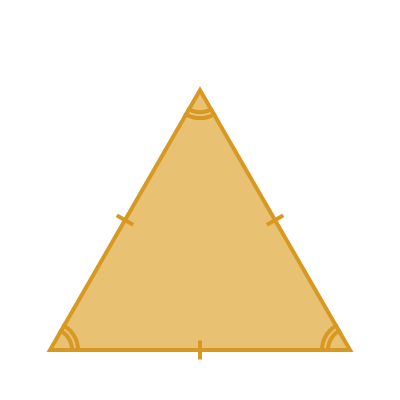
The tick marks on the three sides indicate that the sides are the same length.
The angle arcs in the corners indicate that the angles are all equal.
Since the three angles of any triangle always add up to 180 degrees, it follows that each angle in an equilateral triangle must be equal to 60 degrees.
And equilateral triangle is a regular polygon. All equilateral triangles are the same shape, but can be different sizes (we say they are similar).
Isosceles triangles
An isosceles triangle has two sides that are equal in length. The third side is not equal to the other two (it can be longer or shorter).
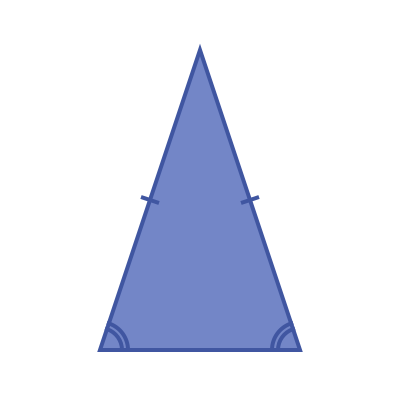
We sometimes call the two equal sides the legs of the triangle, and the other side the base.
Each leg makes an equal angle with the base.
Scalene triangles
A scalene triangle has three unequal sides.
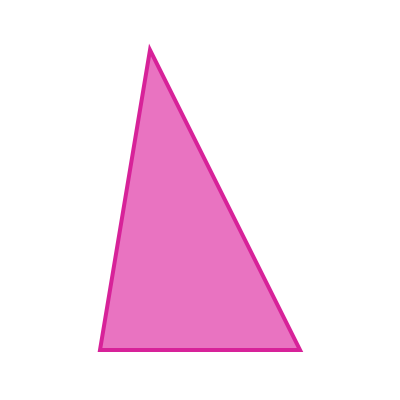
All three angles in a scalene triangle are also unequal.
Acute triangles
A triangle is acute if all three of its angles are less than 90 degrees.
All the triangles shown above are acute.
Obtuse triangles
A triangle is obtuse if one of its angles is greater than 90 degrees.
Here is an obtuse isosceles triangle:

An obtuse isosceles triangle has a wide base, which means that the top angle (the angle where the legs meet) is larger than 90 degrees. The two legs are the same length, and the two angles at the base are equal.
Here is an obtuse scalene triangle:
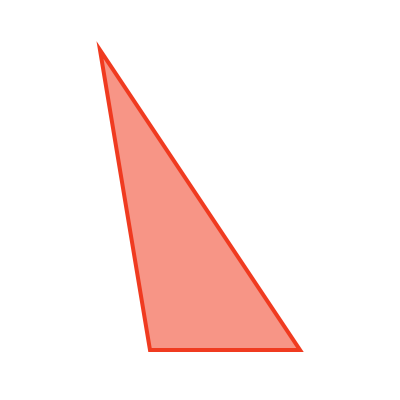
In this case, all the sides have different lengths and all the angles are different, but the shape has one angle that is greater than 90 degrees.
It is impossible for a triangle to have more than one angle that is greater than 90 degrees because the sum of all three angles is 180 degrees.
An equilateral triangle can't be obtuse, because all the angles of an equilateral triangle are 60 degrees.
Right-angled triangles
A right-angled triangle has one angle of exactly 90 degrees.
Here is a right-angled isosceles triangle:
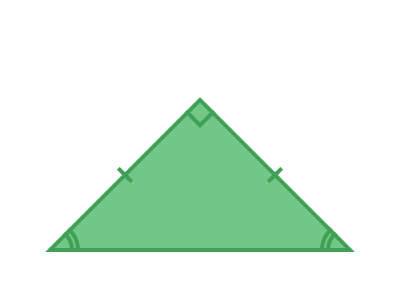
As before the two legs of an isosceles triangle are the same length and the two angles at the base are equal.
Since we know that the other angle is 90 degrees, this means that the two angles at the base must both be equal to 45 degrees (because 90 + 45 + 45 is 180).
This means that all right-angled isosceles triangles are the same shape. They can be different sizes (they are similar).
A right-angled scalene triangle is similar, but the legs are different sizes:
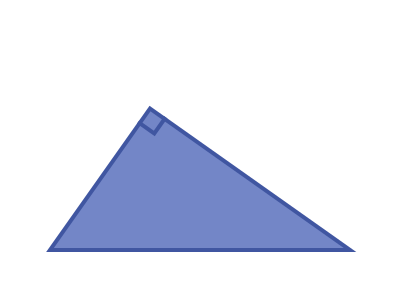
The sum of the two angles at the base is 90 degrees.
An equilateral triangle can't be right-angled, because all the angles of an equilateral triangle are 60 degrees.
Summary
There are seven types of triangle:
- Equilateral triangles (that are always acute).
- Isosceles triangles (that can be acute, obtuse, or right-angled).
- Scalene triangles (that can be acute, obtuse, or right-angled).
See also
- Regular polygons
- Interior and exterior angles of a polygon
- Quadrilaterals
- Quadrilateral family tree
- Pentagons - polygons with 5 sides
- Hexagons - polygons with 6 sides
- Heptagons - polygons with 7 sides
- Octagons - polygons with 8 sides
- Nonagons - polygons with 9 sides
- Decagons - polygons with 10 sides
- Hendecagons - polygons with 11 sides
- Dodecagons - polygons with 12 sides
- n-gons - polygons with any number of sides
- Other types of polygon
- Star polygons

Join the GraphicMaths Newletter
Sign up using this form to receive an email when new content is added:
Popular tags
adder adjacency matrix alu and gate angle answers area argand diagram binary maths cartesian equation chain rule chord circle cofactor combinations complex modulus complex polygon complex power complex root cosh cosine cosine rule countable cpu cube decagon demorgans law derivative determinant diagonal directrix dodecagon eigenvalue eigenvector ellipse equilateral triangle euler eulers formula exercises exponent exponential exterior angle first principles flip-flop focus gabriels horn gradient graph hendecagon heptagon hexagon horizontal hyperbola hyperbolic function hyperbolic functions infinity integration by parts integration by substitution interior angle inverse hyperbolic function inverse matrix irrational irregular polygon isosceles trapezium isosceles triangle kite koch curve l system line integral locus logarithm maclaurin series major axis matrix matrix algebra mean minor axis n choose r nand gate net newton raphson method nonagon nor gate normal normal distribution not gate octagon or gate parabola parallelogram parametric equation pentagon perimeter permutations polar coordinates polynomial power probability probability distribution product rule proof pythagoras proof quadrilateral questions radians radius rectangle regular polygon rhombus root sech segment set set-reset flip-flop sine sine rule sinh sloping lines solving equations solving triangles square square root standard curves standard deviation star polygon statistics straight line graphs surface of revolution symmetry tangent tanh transformation transformations trapezium triangle turtle graphics uncountable variance vertical volume volume of revolution xnor gate xor gate